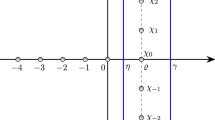Abstract
We study the boundary of the range of simple random walk on \(\mathbb {Z}^d\) in the transient case \(d\ge 3\). We show that volumes of the range and its boundary differ mainly by a martingale. As a consequence, we obtain an upper bound on the variance of order \(n\log n\) in dimension three. We also establish a Central Limit Theorem in dimension four and larger.
Similar content being viewed by others
References
Asselah, A., Schapira, B.: Moderate deviations for the range of a transient walk: path concentration. arXiv:1601.03957
Benjamini, I., Kozma, G., Yadin, A., Yehudayoff, A.: Entropy of random walk range. Ann. Inst. Henri Poincaré Probab. Stat. 46, 1080–1092 (2010)
Berestycki, N., Yadin, A.: Condensation of random walks and the Wulff crystal. arXiv:1305.0139
Chen, X.: Random walk intersections, large deviations and related topics. In: Mathematical Surveys and Monographs, vol. 157. AMS, New York (2009)
Durrett, R.: Probability: Theory and Examples, vol. 4. Cambridge University Press, Cambridge (2010)
Dvoretzky, A., Erdós, P.: Some problems on random walk in space. In: Proceedings of the Second Berkeley Symposium on Mathematical Statistics and Probability, pp. 353–367. University of California Press, Berkeley (1951)
Hebisch, W., Saloff-Coste, L.: Gaussian estimates for Markov chains and random walks on groups. Ann. Probab. 21, 673–709 (1993)
Hammersley, J.M.: Generalization of the fundamental theorem on subadditive functions. Proc. Cambr. Phil. Soc. 58, 235–238 (1962)
Jain, N.C., Pruitt, W.E.: The range of transient random walk. J. Analyze Math. 24, 369–393 (1971)
Lawler, G.F., Limic, V.: Random walk: a modern introduction. In: Cambridge Studies in Advanced Mathematics, vol. 123. Cambridge University Press, Cambridge (2010)
Le Gall, J.-F.: Propriétés d’intersection des marches aléatoires. I. Convergence vers le temps local d’intersection. Commun. Math. Phys. 104, 471–507 (1986)
Mathieu, P., Sisto, A.: Deviation inequalities and CLT for random walks on acylindrically hyperbolic groups. arXiv:1411.7865
Okada, I.: The inner boundary of random walk range. J. Math. Soc. Japan 68, 939–959 (2016)
Okada, I.: Frequently visited site of the inner boundary of simple random walk range. arXiv:1409.8368
Acknowledgments
We would like to thank Gregory Maillard for discussions at an early stage of this work. We thank Pierre Mathieu for mentioning that we omitted to show that the limiting term in (1.14) was nonzero, and Perla Sousi for mentioning a few other inaccuracies. Finally, we thank an anonymous referee for his very careful reading, and his numerous corrections and suggestions which greatly improved the presentation. A.A. received support of the A\(^*\)MIDEX Grant (ANR-11-IDEX-0001-02) funded by the French Government “Investissements d’Avenir” program.
Author information
Authors and Affiliations
Corresponding author
Appendix: Estimates on ranges
Appendix: Estimates on ranges
In this section, we prove Proposition 1.5. We first introduce some other range-like sets allowing us to use the approach of Jain and Pruitt [9]. Recall that the sets \(\mathcal {R}_{n,V}\) are disjoint, and for \(U\subset V_0\), define
Next for \(U\subset V_0\), define
The definition (5.15) yields
and this relation is inverted as follows:
As a consequence, for \(V\subset V_0\),
We will see below that each \(\overline{\mathcal {R}}_{n,V}\) has the same law as a range-like functional that Jain and Pruitt analyze by using a last passage decomposition, after introducing some new variables. But let us give more details now. So first, we fix some \(V\subset V_0\), and for \(n\in \mathbb {N}\), set \(Z_n^n=1\), and
where
A key point in this decomposition is that \(Z_n\) and \(Z^n_i\) are independent. Now, define
Since the increments are symmetric and independent, \(|\overline{\mathcal {R}}_{n,V}|\) and \(|\underline{\mathcal {R}}_{n,V}|\) are equal in law. Now, equality (5.16) reads as
Now using that Var\((|\overline{\mathcal {R}}_{n,V}|)\le \mathbb {E}[( |\overline{\mathcal {R}}_{n,V}|-\sum _{i\le n-1} \mathbb {E}[Z_i])^2]\), and that \((a+b)^2\le 2(a^2+b^2)\) we obtain
Next for \(i<j< n\), we have (recall the definition (2.1))
where for the second equality we just used the Markov property and translation invariance of the walk. The last inequality is written to cover as well the case \(i=j\). Therefore,
Then Lemma 4 of [9] shows that
and thus
Now, for \(i<j<n\), by using that \(Z_i^j\) and \(Z_j\) are independent, we get
On the other hand, assuming \(i<j\le n\),
Since in addition,
and
we deduce that
with
Now we need the following equivalent of Lemma 5 of [9].
Lemma 5.4
For any \(V\subset V_0\), and \(x\notin \overline{V}\),
with
Moreover,
Assuming this lemma for a moment, we get
from which we deduce that
Then Proposition 1.5 follows from (5.17), (5.18) and (5.20).
Proof of Lemma 5.4
Note first that
Moreover,
The first assertion of the lemma follows. The last assertion is then a direct consequence of standard asymptotics on the gradient of the Green’s function (see for instance [10, Corollary 4.3.3]). \(\square \)
Remark 5.5
By adapting the argument in [9] we could also prove that in dimension 3, \(\text {Var}(|\underline{\mathcal {R}}_{n,V}|) \sim \sigma ^2 n \log n\), for some constant \(\sigma >0\), and then obtain a central limit theorem for this modified range. However it is not clear how to deduce from it an analogous result for \(|\mathcal {R}_{n,V}|\), which would be useful in view of a potential application to the boundary of the range.
Rights and permissions
About this article
Cite this article
Asselah, A., Schapira, B. Boundary of the range of transient random walk. Probab. Theory Relat. Fields 168, 691–719 (2017). https://doi.org/10.1007/s00440-016-0722-4
Received:
Revised:
Published:
Issue Date:
DOI: https://doi.org/10.1007/s00440-016-0722-4



